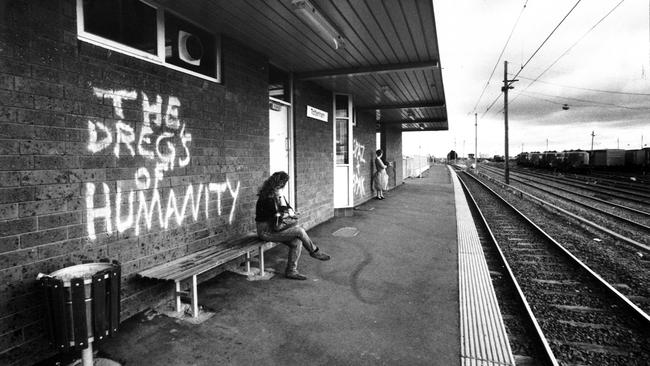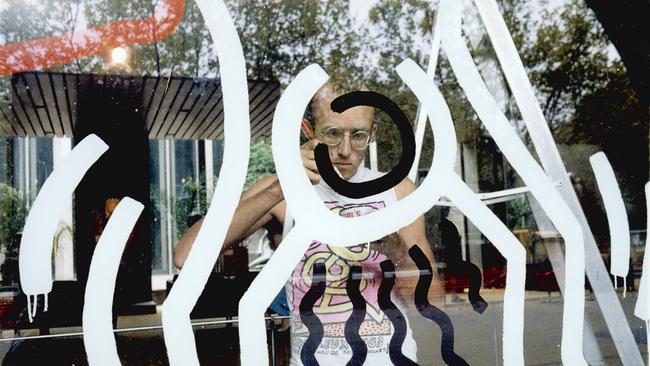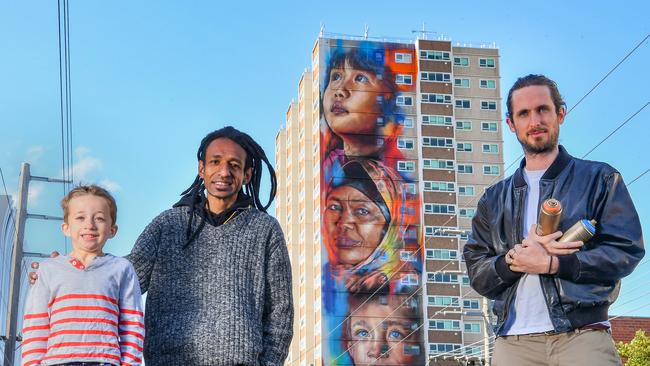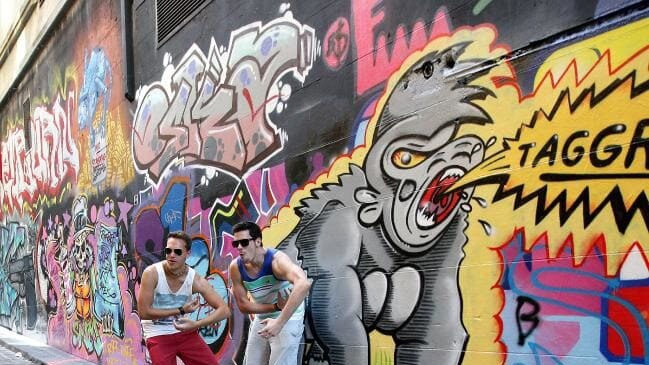The colourful history behind Melbourne’s most iconic street art
How did Melbourne become home to some of the world’s best street art? Take a look at the evolution of hot spots such as Hosier Lane and some of our most iconic murals.
Lifestyle
Don't miss out on the headlines from Lifestyle. Followed categories will be added to My News.
Melbourne has long cemented its status as one of the street art capitals of the world.
But before artist-led walking tours regularly topped the list of Melbourne’s most popular tourist attractions and Hosier Lane set the scene for the urban wedding album, there were kids with spray cans and something to say.
Tracing the origins of Melbourne’s street art scene depends on your definition of its predecessor, graffiti.
Street art scholar and associate professor of The MIECAT Institute Dr Lachlan MacDowall said while most experts agree modern graffiti arrived in Melbourne by way of New York in the early 1980s, the writing was on our walls well before that.
“People were writing political messages, there were community murals around nuclear disarmament, ” Mr MacDowall said.
“We also had local traditions of young people writing their names in the street – I can remember my cousins writing their names on their names on their local phone box.”

When graffiti took off as a product of the rise in hip hop culture that was sweeping the globe, Australia’s geographical isolation in meant that most young people were only exposed to snippets of the New York art scene through movies and music videos.
“Very few young people could travel to New York themselves, so they had to reimagine and reinvent graffiti and these artists developed a strong regional style,” Mr MacDowall said.
Graffiti was still in its infancy when Keith Haring arrived in Melbourne in 1984 as one of the biggest names of the New York street art scene, and painted the now iconic mural on the wall of the former Collingwood Technical College in Johnston Street.
Haring’s work will be celebrated in Melbourne alongside fellow contemporary artist Jean-Michel Basquiat this summer for the NGV’s blockbuster exhibition Keith Haring/Jean-Michel Basquiat: Crossing Lines.
NGV’s senior curator of Australian art David Hurlston said Haring’s visit, during which he spent time with young graffiti writers and painted another mural on the NGV’s iconic water wall, was important international exposure for Melbourne’s burgeoning street scene.

“Information wasn’t shared the same way, so Haring had an influential role in local artists developing their own style,” he said.
Mr MacDowall agreed: “At the time, Melbourne was still coming to grips with his work, but we’ve become a lot more appreciative of his contribution to visual art.”
Throughout the 1990s, graffiti writers became more sophisticated in their materials and methods, and developed a regional style of intricate lettering known as Melbourne ‘wildstyle’.
Graffiti vs street art?
Most people don’t realise there is a difference between graffiti and street art, and it’s not as simple as kids tagging train carriages versus council-sanctioned murals on high-rise estates.
At the most basic level, graffiti is based around stylised words, while street artists usually incorporate symbols and imagery.

Mr MacDowall said graffiti writers and street artists have completely different motivations and adhere to different rules, for example, the use of stencils are almost forbidden in graffiti culture but commonplace in the work of street artists such as Banksy and Blek le Rat.
“Graffiti tends to be a bit more subversive, and more about artists talking to other artists where street art seeks a broader audience,” he said.
“But the two forms really art related … you could argue that graffiti liberated the streets for street art to develop.”
Street art goes mainstream
The early 2000s was a period of great political engagement among young street artists in Melbourne, who were prolific in their responses to the 9/11 terrorist attacks and the US invasion of Afghanistan and later Iraq.
The internet brought street art into mainstream consciousness and Melbourne’s most decorated laneways began appearing on travel blogs and in Lonely Planet guides. Artists such as Rone, Duel, Ha-Ha, Kaff-eine, Meggs, Fintan Magee and Adnate became household names.

It wasn’t long before brands began to engage street artists to produce murals that promoted their products – anything from footwear to films.
“People realised they could make a career out of being a street artists in corporate spaces or within art institutions, which was quite unprecedented when you think we were talking about 12 and 13-year-old kids messing around with cans of spray paint,” Mr MacDowall said.
While some street artists have derided the murals as ‘selling out’, David Hurlston said street artists were commercialising their work long before this current wave of ‘brandalism’.
“If you go all the way back to [Keith] Haring, he was covering social issues but he was also aware of the commercial aspects of the work,” he said.
“Some of the top street artists today, Banksy, Shepard Fairey, have managed to produce work that is subversive while still exploiting a commercial aspect.”
“But there is a point where you can go beyond what is reasonable – artists doing wedding portraits in Hosier Lane so couples can get their picture taken in front of them, that’s a sell out as far as I’m concerned.”
Mr MacDowall says that while street art has “detached from its original context”, social media has helped street artists find new audiences, and commercialisation has provided some with the opportunity to forge a successful career in the art world.
“It’s quite amazing that you can paint something in a laneway in Fitzroy and have it reach a global audience.”
“I don’t see (commercialisation) as a long slide into mainstream, the most interesting artists are the ones that are constantly reinventing themselves,” he said.
But there is one staple of Melbourne’s street art scene he believes will never be replaced.
“Street art sites are popping up all over the city and suburbs, but Hosier Lane has this unique combination of history and location, Mr McDowall said.”
“There is something quite remarkable about it that can never really be replicated.”
Where to find Melbourne’s best street art
You’ve snapped a selfie in Hosier Lane, now continue on your exploration of Melbourne’s best murals at these street art hot spots.
Rutledge Lane, CBD
Artist Adrian Doyle caused a storm of controversy in 2013 when he painted the entire length of Rutledge Lane a blockout baby blue, wiping out every other piece of artwork. Some lamented the loss of the existing works, but street artists saw it as a blank canvas and new works popped up overnight.
AC/DC Lane, CBD
Music legends dominate the walls of AC/DC Lane, which was named for the band in 2004 and is home to iconic music venue Cherry Bar. Keep walking to discover more murals in nearby Duckboard Place.
Johnston Street & Rose Street, Fitzroy
Fitzroy is a veritable hotbed of iconic street art, from the Fitzroy Faces on Cecil Street and Everfresh mural on the corner of Johnston and Young streets, to the kaleidoscope of colour lining the walls near Rose Street Artists’ Market.
MORE NEWS
THE ULTIMATE MELBOURNE STREET ART COLLECTION
MELBOURNE STREET ART: CREMORNE NYLEX CLOCK TRANSFORMED
KEITH HARING, JEAN-MICHEL BASQUIAT HEADLINE NGV SUMMER EXHIBITION
Keith Haring mural, Collingwood
Keith Haring painted this mural on the wall of the former Collingwood Technical College on his visit to Melbourne in 1983 and it remains one of our oldest and most significant pieces of street art.
The artist signed his name on a service door below the wall, but it was stolen around the time of his death from an AIDS-related illness in 1990. The door was anonymously returned to Creative Victoria in 2003, and will be publicly displayed for the first time as part of Keith Haring/Jean-Michel Basquiat: Crossing Lines.
Sunshine Lane, Brunswick
Brunswick factory owner and street art fan Dean Sunshine handed the space behind his fabric warehouse over to street artists in the early 2000s. Located just off Lygon Street, Sunshine Lane is now an ever-changing outdoor gallery of street art, stencil art and graffiti.
Keith Haring/Jean-Michel Basquiat: Crossing Lines opens at NGV on December 1.
